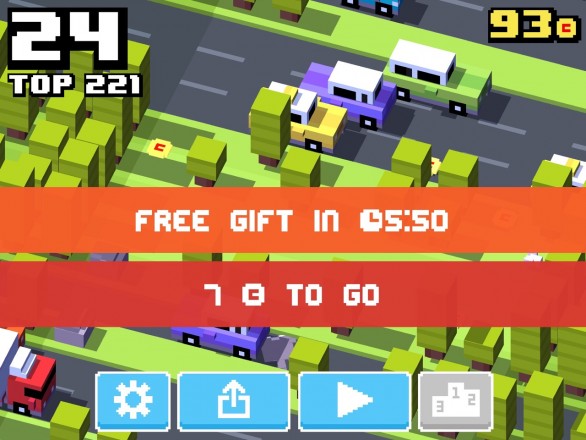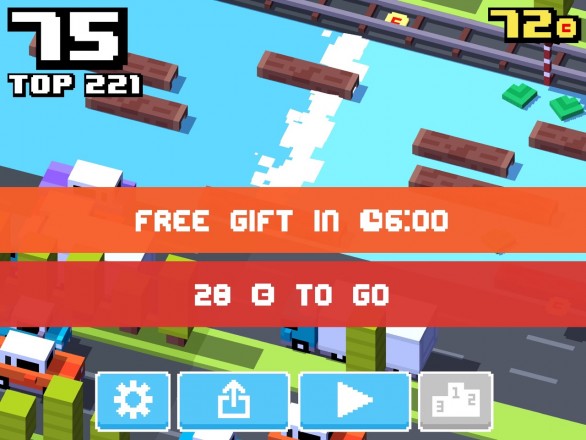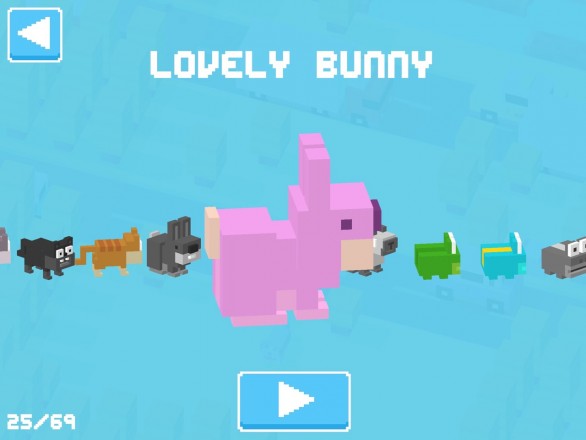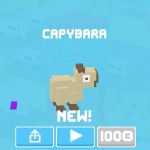The epic list of game mechanics at work in Crossy road, the hit iPad game, might inspire you to gamify whatever you’re working on.
Crossy road is a simple and wonderful game, based on the arcade classic Frogger. It swept the iOS world in November and December. And it’s still sweeping.
There’s nothing to it – just and infinite sequence of roads and rivers to cross until you die. Why is it so compelling? Here’s how they encourage you to keep playing…
Loveliness
You can tell the makers love gaming and loved making their game. It’s ingeniously stylish to look at, and has a great sense of humour. Those are key: if the game was ugly and joyless, the game mechanics alone wouldn’t stand a chance. But the first couple of persuasion/gaming principles are there:
- Liking: The game is loveable and it’s easy to be friends with it. We all like hanging out with nice people in nice places.
- The halo effect: it’s a lovely looking game – unconventional, stylish and “in”. So that must mean it’s worth spending time with, right?
Goals: Micro and macro
A good game needs a clear goal. It’s one of the key principles of Flow. There are several layers of goal in Crossy road, which will keep you motivated on the time scale of seconds all the way up to weeks.
- seconds: get as far as you can in one game
- minutes: collect enough coins to buy another avatar
- hours: beat your personal best
- days: beat your friends via game centre leaderboard (their scores are marked right on the game board so you can see them “in the flow” of the game).
- weeks: collect all the avatars
Building your collection
Arguably the uber goal of the game is to build a complete collection of avatars. Collection is great because:
- Endowment effect and ikea effect: You feel like you’re building something of your own
- Closure: You’re working towards the complete set
- Flow: Every time you get one more item you’re making visible progress towards your goal.
In addition, collections multiply the value of each individual gain. Adding one item to your collection makes the whole collection feel new, so you get the feeling of gaining something bigger: an improved collection.
This is the only place where the game attempts to monetise. The authors say that they wanted to take a different approach to monetisation: You can play quite happily without every paying a penny. But if you’re going to spend it on anything, they think you’ll spend it to complete your collection of avatars.
Social
- Competition: Yes that leaderboard is a social mechanism. Being best at Crossy road is an important skill and a way to clearly establish your superiority to all your friends. Right?
- Social currency: For something awesome to share with your friends, you can record your game play and share it so that the world can witness your finest hour.
Variable rewards
After a pre-determined time (often 6 hours) you get a gift of a random amount of “cents”. You can spend the cents on a random avatar to add to your collection. So we’ve got…
- Appointment/incentive to return: Knowing you’ll get another gift in a few hours creates a sort of “appointment” dynamic. Don’t forget to check the game in a few hours time to see if you’ve got a new reward.
- Skinner box 1: The cents gift is a variable reward, which means it’s a skinner box. Variable reward is more compelling for longer, than a fixed and predictable reward is.
- Skinner box 2: When you collect 100c (usually 1 gift’s worth), you can get a gift from the gift machine, containing a random avatar for your collection. Another skinner box!
Try for FREE, and get a FREE gift
After a few goes, the game gives you a choice of a few avatars that are not in your collection and you can try one for three turns. After 3 turns, you have to “give it back”, or choose to buy it for 69p and get an extra 250c thrown in for free. So we’ve got…
-
- Endowment effect: it’s hard to give back something that you have “owned”. (The power of a free trial).
- Power of Free: When you pay 69p you also get 250c for FREE. Dan Arielly fans will know all about the power of free stuff to make people do things they would normally not consider.
Tight game loop
You’re practising a (mostly pointless) skill and there’s that drive to “just try one more time because I was SO CLOSE”, that propelled Angry Birds to the top of the charts. The moment you die you can restart as fast as humanly possible, so that you can stay in the zone and master that skill. It’s that heady mix of dopamine and opiates that keeps us trawling Pinterest or Twitter, looking for info-gems.
In a funny way, each level is a skinner box: Play one more time and you might get lucky and set new personal best.
Packing this many persuasive design techniques into such a simple app is quite impressive. But I have a sneaking suspicion there may be more hiding in there. What have I missed?




